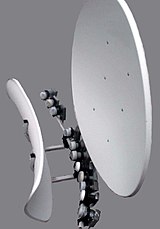Satellite television in the United States
Currently, there are two primary satellite television providers of subscription based service available to United States consumers: DirecTV and Dish Network, which have 21 and 10 million subscribers respectively.
[1][2] In December 1975, RCA created Satcom 1, the first satellite built especially for use by the then three national television networks (CBS, NBC, and ABC).
Later that same year, HBO leased a transponder on Satcom 1 and began transmission of television programs via satellite to cable systems.
In 1979, the Satellite Home Viewers Act allowed homeowners in the United States to both own and operate their own home satellite system, consisting of C-band equipment from a multitude of manufacturers who were making parts for systems such as Taylor Howard's, and began a large controversy of which channels could be received by whom.
In 2004, Cablevision's Voom service went online, specifically catering to the emerging market of HDTV owners and aficionados, but folded in April 2005.
Many religious broadcasters reach the DTH and distribution markets with unencrypted DVB-S television and radio channels on Galaxy 19.
Specific FTA offerings tend to appear and disappear rather often and typically with little or no notice, although sites such as LyngSat do track the changing availability of both free and pay channels worldwide.
[8] On February 11, 2010, Senate Majority Leader Harry Reid said the satellite reauthorization was part of a jobs bill[clarification needed].
[10] On March 1, 2010, The Satellite Television Extension and Localism Act of 2010, scheduled to expire in 2014, became part of a jobs bill with help from Sen. Patrick Leahy.

